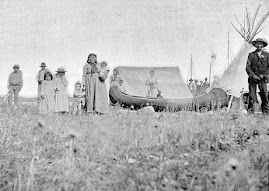
Wednesday, January 30, 2008
Richard Woodhouse Sr and Family(1899) at Fairford

Friday, January 25, 2008
Indian Act and the Consequence(s) Past and Present
How did this happen? When the treaties of our country were built on a nation-nation relationship with the Crown. Treaties are visionary documents meaning to create a 'foundation of self-sustainability and determination' for those yet to come. Therefore, the laws that affect our people including the Indian Act should not apply. It works agains't the ideal of 'autonomous relation's' with the Crown. More to come on this post! To discuss the agenda of divide and conquers tactics also the social and political conditioning of our people and the affects of the future.
Funding fo First Nations,Organizations and Government exploitation of resources
The reporting of of funding of 99,999 or less 25,000 is displayed on the departmental websites http://www.tbs-sct.gc.ca/pd-dp/gr-rg/index_e.asp ... The funding displayed at the next post is funding of $100,000 or more to each FN. However, I will include the funding release date per quarter(3 month(s) intervals shortly. The quarterly funding will increaes the funding for the fiscal year for each FN. However, some funding is delivered through multi year contribution agreements, for instance health.
The provincial government reporting is not available in certain provinces(like Manitoba which is un-audited statements)All provinces should have reporting requirments that is similar to the federal government reporting requirments set out by the Treasury Board or the Auditor-General of Canada.
]
This is where federal complaints by band members or individuals should be sent to! Why? INAC is a very lazy department it a revolving door of Modern Indian Agents or it can be stated their missing in action MIA they are never there or they might say to get info a BCR is needed it should be called CCR Chief and Council resoultion. The band is not involved in the process when drafting of a resoultion. Should be an open meeting when a resoultion is passed, but band member are usually not involved in the decision making process of the resoultion However ,we have to move away from the Indian Act guidlines it too restrictive!
The federal legislation called Financial Accountability Act( http://www.faa-lfi.gc.ca/faa-lfi/faa-lfi14_e.asp)should applys to the government not just FN's when doing business with chief and council(Delgamauuk..Supreme Court stated: Chief and Council are the adminstrative arm of the federal government so the Indian Act does apply, the supreme court says so). The templates they use for reporting is to burdensome to many reports and their audited reports are to loose it should be be more forensic(detailed); but we should start by building these templates of accountabilty ourselves to set an example for government to follow. Then maybe they can use our templates of reporting on where the money is going on exploitation of our resources in each treaty territory! In our treaty area in particular where 87.6 Billion dollars(Resource Extraction) has been usurped since Treaty TWO(1871) was signed by our ancestors. Theft of our minerals such as: Gypsum(hence the word Gypsumville) this used to make Dry Wall, Gravel, Lime, Cement(Steeprock) to make their paved road and buildings ,Fishing, Logging,Railway Transportation, Hydro Transmission lines...etc Its great to be acountable but accountability works both ways! However, The INDIAN ACT is the problem we have to focus on treaty revitilization because currently it's on life support!
Wednesday, December 19, 2007
Transfer Payments To Each First Nation Within The Interlake Reserves Tribal Council for Fiscal year 2006-2007
$ 1,304,366
of supplying public services in Indian government
support.
social development.
$1,523,442
*Payments for post-secondary education is controlled by Lake St Martin this amount will be based on population demographics established by INAC. Lake st Martin withdrew post-secondary dollars from the Interlake Tribal to disperse to their own band members. However, other services my be delgated to IRTC.
*HRDC dollars funding dispersal is as listed as above as other FNS under the First People Development Inc of which $15,173,948 is allocated to southern FN's.
Provincial Funding
$0
Friday, December 14, 2007
Population Demographics of Interlake Reserve Tribal Council membership
Funding to Interlake Reserves Tribal Council and other affiliated service delivery agents within the area. It also includes funding to each particular band within the Tribal Councils mandate of who they serve. Which usually is chiefs within the particular First Nation who sit in on the board of directors. Also included is funding to each Political Territorial Organization of whom each member First nation is afilliated with. These bands are:
- Pinaymootang -Total registered population as of Nov 2007, 1119 on-reserve and 1562-off-reserve.Total population of 2681.
- Little Saskatchewan-Total registered population as of Nov 2007, 614 On-reserve and 421 off-reserve. Total Population of 1035.
- Lake St Martin-Total registered Population as of Nov 2007, 1352 on-reserve and 736 off-reserve. Total population of 2086.
- Dauphin River-Total registered Population as of Nov 2007, 199 on-reserve and 84 off-reserve. Total Population of 283.
- Lake Manitoba-Total registered Population as of Nov 2007, 888 on-reserve and 819 0ff-reserve. Total Population of 1717.
- Peguis-Total registered Population as of Nov 2007, 3505 on- reserve and 4733 off-reserve. Total population of 8248.
- Jackhead-Total registered Population as of Nov 2007, 343 on reserve and 332 off-reserve. Total Population of 675.
Total membership of 15,725(8,038 on-reserve) within Interlake Reserve Tribal Council(s) members with approximately half residing off- reserve(7,687). The membership in this area is also under the mandate of the Southern Chiefs Organization and Assembly of Manitoba Chiefs and the Assembly of First Nations at the national level.
This is the first part of four to discuss per capita distributions within each First Nation membership based on population demographics within the Tribal Council area. Part two will include funding to each perspective band for the fiscal year 2006-2007 ending April 1. It will also include funding from the Province of Manitoba.


